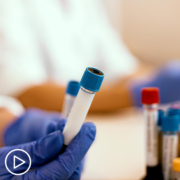Myeloproliferative Neoplasms Archives
Myeloproliferative neoplasms (MPNs) are a closely related group of progressive blood cancers in which the bone marrow typically overproduces one of the mature blood elements. Other shared features include tendencies toward blood clotting/bleeding, organ enlargement, bone marrow scarring (fibrosis) and a possibility of transformation.
More resources for Myeloproliferative Neoplasms from Patient Empowerment Network.
Shared Decision-Making: The Patient’s Role in Treatment Choices
Shared-Decision Making: The Patient’s Role in Treatment Choices from Patient Empowerment Network on Vimeo.
What is the role of the patient when it comes to treatment choices? Dr. Brady Stein details how he partners with patients in decision-making for their MPN care.
Dr. Brady Stein is a hematologist focusing on myeloproliferative neoplasms (MPNs) at the Robert H. Lurie Comprehensive Cancer Center of Northwestern University. Learn more about Dr. Stein, here.
Related Resources

|

An Expert Shares Key Steps to Take Following an MPN Diagnosis |

|
Transcript:
Katherine:
What do you feel is the patient’s role in the decision for therapy?
Dr. Stein:
I think it’s a really important role. I think historically – and, this is decades past; this era should be well over and behind us – this era of authoritative medicine is over.
You can’t just have a doctor walk in the room and say, “This is your treatment, this is what you should do, I’ll see you later.” It’s shared decision-making, and that can be troubling for some patients. But, the idea of shared decision-making is us explaining options informing the patient and making decisions together. That’s really the paradigm for modern contemporary medicine.
Some patients have a harder time with that. A lot of patients say, “Well, doc, this is too overwhelming for me. I just want you to decide for me.” And, we try not to do that. That’s a more uncomfortable type of visit for me when a patient is very deferential and says, “Whatever you say, I’ll do.” That’s not really what we want to hear. I want to know that you feel really informed, that you have a good understanding because each of these treatments – any treatment, any medication has its pros and cons.
There are no real magic bullets, and each upside has an equal downside, so you have to engage and open a dialogue, and what that means is that patients need to read and learn. That’s hard, but patients need to become proactive in their approach to their own illness, and all the patients who are listening now are doing that, trying to get more education about your relatively rare illness that’s going to give you a much better framework to help make decisions together.
Katherine:
Absolutely. If a patient isn’t feeling confident with their treatment plan or their care, do you recommend that they maybe consider a second opinion or seek a specialist?
Dr. Stein:
Of course, yeah. These are rare diseases, and patients often – I would say that in my clinic, a lot of the patients direct their own second opinions. Oftentimes, it’s coming from the patient more so than their doctor. I think the patient community is very active, the patients are networking, and they’re finding the right specialist to get to.
I think it should be really a team approach. It’s never – it’s usually not very convenient to go to a university unless you live really close, so you want to have someone close to home who can handle the routine, and then, someone who maybe is a little bit further away who can see you once a year, can help with the big decisions, can be part of the healthcare team. So, we generally recommend that you have someone near, and that maybe you have someone far who focuses only on MPNs as part of your team, and now, it’s a little different. Telemedicine is becoming a pretty ingrained part of medicine. It’s a little easier to have those visits with a physician who’s far away because of telemedicine.
Self-Advocacy: Advice for Being a Pro-Active MPN Patient
Self-Advocacy: Advice for Being a Pro-Active MPN Patient from Patient Empowerment Network on Vimeo.
How can myeloproliferative neoplasm (MPN) patients be more pro-active in their care? Dr. Brady Stein shares advice to help patients educate themselves about the disease, while finding the right balance of knowledge to prevent them from feeling overwhelmed.
Dr. Brady Stein is a hematologist focusing on myeloproliferative neoplasms (MPNs) at the Robert H. Lurie Comprehensive Cancer Center of Northwestern University. Learn more about Dr. Stein, here.
Related Resources

|

|

|
Transcript:
Katherine:
Let’s talk about patient self-advocacy now, Dr. Stein. Patients can sometimes feel like they’re bothering their healthcare team with their comments and questions.
Why is it important for patients to speak up when it comes to symptoms and side effects?
Dr. Stein:
I smile a little bit because patients – I get a lot of patient emails by MyChart. That’s our medical record, and it’s a secure patient email, and a lot of patients will start their message by saying, “I’m sorry to bother you.”
And, I always say, “Why do you think that? It’s my job. Please don’t apologize for reaching out to me.” So, that’s kind of the first thing. Don’t feel like you’re bothering your doctor. There are certain things that we won’t know unless you tell us, and so, I think that’s pretty clear. When we’re in a patient room and there might be a husband and wife together, and whether it’s the husband is the patient or the wife is the patient, we might ask a question, and we might get, “No, everything is fine,” but all doctors kind of sneak over to the partner, and the partner may be saying – they’re making gestures to us. There may be nonverbal forms of communication to tell us there’s something much worse than what the patient is telling you.
So, again, “advocate” meaning you have to tell us what’s going on with you. If you’re worried about something, please don’t be stoic about it. These diseases are treated a lot based on your symptoms, and so, if you don’t tell uls about your symptoms, we won’t know.
And, in terms of advocacy, I think one of the things is that these are pretty rare diseases. In an academic center, no, this is our focus, but if you’re in a community practice where the doctor’s seeing 10-15 different things during the course of a day, it’s basically impossible to keep up with myelofibrosis, especially if you have one patient in your whole practice. I can’t do that for diseases that I see that I have only one patient. The medical literature can be overwhelming.
So, patients can quickly outpace their doctor in terms of their knowledge of these diseases, but I think it’s really important to read, to learn, and to think about the illness because you may find out things through your research that your doctor wouldn’t know are available. You may find a clinical trial, a new strategy, or a new test that they simply haven’t had the time to keep up with or learn about. So, that’s what advocacy is about. Reading is really important, but you have to find a balance. I want my patients reading, but you’ve got to find the right amount because there’s a certain amount of reading where the patients start to get overwhelmed.
All patients kind of get to this point. They take it in – like taking it in like a fire hydrant in the beginning of the disease, and it’s overwhelming, and then they start to find their balance. I think there’s a point where the reading becomes anxiety-provoking rather than ameliorating anxiety, and all patients just generally find their balance.
Is My MPN Treatment Working?
Is My MPN Treatment Working? from Patient Empowerment Network on Vimeo.
During myeloproliferative neoplasm (MPN) treatment, specific blood tests and diagnostic measurements help to gauge a patient’s treatment response. Dr. Brady Stein details the criteria he assesses in monitoring the efficacy of a therapy, including patient-reported outcomes.
Dr. Brady Stein is a hematologist focusing on myeloproliferative neoplasms (MPNs) at the Robert H. Lurie Comprehensive Cancer Center of Northwestern University. Learn more about Dr. Stein, here.
Related Resources

|

|

|
Transcript:
Katherine:
Once a patient has started treatment, how do you know it’s working?
Dr. Stein:
That’s a good question because this is a very unique area. Yes, of course, in some respects, it’s straightforward with ET or PV. If we’re starting a medication to control a blood count in hopes of having lowered the thrombosis risk, you can look objectively at blood counts.
Okay, your hematocrit is at this goal? Yes, therapy’s working. You have not had a blood clot?
Yes, therapy’s working. So, there are some objective things. In myelofibrosis, there are some objective things like measuring the spleen and seeing it reduce. You can feel that with your hands, or you can do an ultrasound. So, there are some objective parameters of success. But, in this area, patient-reported outcomes are really important, and so, a measure of success is really just asking the patient, “Do you feel like your drug is working? Do you feel better?
It’s kind of a simple question, but it’s really important, and it’s what we ask in patients who are on certain therapies. “Do you feel like the net effect of your therapy is still positive? Do you feel like it’s helping?” Seems like a straightforward type of question, but I think the answer is extremely informative. When a patient says, “Yes, definitely, my medication is still helping me,” then I know that I don’t need to change it.
MPN Treatment Choices: Where Do Clinical Trials Fit In?
MPN Treatment Choices: Where Do Clinical Trials Fit In? from Patient Empowerment Network on Vimeo.
When considering MPN treatment approaches, clinical trials are a viable option for care. Dr. Brady Stein discusses clinical trials and factors to keep in mind when considering participation.
Dr. Brady Stein is a hematologist focusing on myeloproliferative neoplasms (MPNs) at the Robert H. Lurie Comprehensive Cancer Center of Northwestern University. Learn more about Dr. Stein, here.
Related Resources

|

|

|
Transcript:
Dr. Stein:
Clinical trials are always a treatment – always an option for patients with myeloproliferative neoplasms because while we have some standards, we can definitely improve upon those standards for certain. So, clinical trials are always a therapeutic option. I think the one thing is that it may not – it’s not always the most convenient option, but it could be a really important option if available to you.
So, clinical trials basically offer something new or novel that would not otherwise be available to other patients. So, ruxolitinib (Jakafi) was approved around 2011, but the first clinical trials were in 2007, so that’s the example I give to a patient about the benefit of a clinical trial.The patient can get access to a drug that’s effective perhaps three to four years before it’s commercially available.
That’s really the biggest advantage, is you can get early access to something that could really help you. The downsides are that clinical trials are not usually as convenient as regular care, there are often more visits, and there are a lot of unknowns – unknowns about whether it will work. Some side effects are known and expected; there are others that are unknown. So, it’s a lot to think about, but I think it’s always important to consider, especially if your first-line therapy has not been effective, if it’s losing its touch, it’s a good thing to think about for a second line.
Katherine:
Are there emerging approaches for treating MPNs that patients should know about?
Dr. Stein:
Yeah, absolutely. I think the first question – I think patients are often worried that they have a really rare disease, and why would anyone do research in this area, and that’s – the research community is extremely engaged, the productivity is pretty impressive, and there’s a lot of clinical trials in the space, and I think what I try to explain is pharmaceutical companies aren’t just targeting the most common diseases.
They have interests in rare diseases, and findings in rare diseases can be extrapolated to other diseases that you might think are unrelated, but they can share features, so when you find something working in one space, it can have broad applicability. So, there’s an abundance of research in myeloproliferative neoplasms which are emerging?
In PV, I think there’s quite a possibility that there’ll be a drug approval in 2021, a novel type of interferon called ropeginterferon
That is a drug that’s approved abroad; it’s approved in Europe, and I believe it’s approved in Taiwan, and the FDA is looking at it now. So, it’s a possibility that there’ll be a future option for patients with polycythemia vera. So, yes, it’s research now, but it could be available, and so, that’s the drug that I’m starting to talk more and more about for patients with PV.
In myelofibrosis, you have two JAK inhibitors that are approved, ruxolitinib and fedratinib, you have two others in clinical testing, momelotinib and pacritinib, and then you have a whole other class of what we call non-JAK2 type of therapies targeting the vast array of pathway abnormalities in myelofibrosis.
So, there are a number of different clinical trial options, especially in myelofibrosis. I think that’s the disease area where there are the most clinical trials.
Understanding High-Risk vs Low-Risk Disease in ET, PV & MF
Understanding High-Risk vs Low-Risk Disease in PV, ET & MF from Patient Empowerment Network on Vimeo.
When looking at polycythemia vera (PV), essential thrombocythemia (ET), and myelofibrosis (MF), how is risk determined? Dr. Brady Stein explains factors he examines when assessing risk to provide ideal care for each patient.
Dr. Brady Stein is a hematologist focusing on myeloproliferative neoplasms (MPNs) at the Robert H. Lurie Comprehensive Cancer Center of Northwestern University. Learn more about Dr. Stein, here.
Related Resources

|

|

|
Transcript:
Dr. Stein:
For ET and PV, when we talk about high versus low risk, we’re talking about vascular complications, risk of having a blood clot. We’re not really talking about risk of transformation. We don’t have, I think, wonderful, widely used toolkits to predict those things. We know they can happen, but our treatment is still really based on clotting for ET and PV.
And, MF – each couple of years, the tools that are available to assess prognosis become more and more. So, in MF, we’re using the most comprehensive approach – of course, taking into account things like age and demographics, but also, looking at symptoms, looking at the depth and severity of blood count changes, looking at bone marrow features like the degree of scarring, looking at the rise in blast counts, and then, looking at chromosomes and novel genetic markers. So, we’re definitely the most comprehensive in myelofibrosis at assessing prognosis.
What Are Treatment Options for Essential Thrombocythemia (ET) & Polycythemia Vera (PV)?
What Are Treatment Options for Essential Thrombocythemia (ET) & Polycythemia Vera (PV)? from Patient Empowerment Network on Vimeo.
When considering treatment options for essential thrombocythemia (ET) and polycythemia vera (PV), where do experts begin? Dr. Brady Stein details treatment considerations and how he determines the best approaches for ET and PV patients.
Dr. Brady Stein is a hematologist focusing on myeloproliferative neoplasms (MPNs) at the Robert H. Lurie Comprehensive Cancer Center of Northwestern University. Learn more about Dr. Stein, here.
Related Resources

|

|

|
Transcript:
Katherine:
Let’s start with essential thrombocythemia, or ET.
Dr. Stein:
So, I think the first thing is taking an inventory of symptoms, seeing how symptomatic the patient might be. Again, there are some patients who are asymptomatic or have few symptoms, and they were told of a high platelet count during a routine visit, so some patients can be observed if they have few symptoms, and especially if they fall into a lower vascular risk category.
So, symptom assessment first. Second, looking at vascular risk, and there are four categories of risk in in ET in terms of predicting the likelihood of a future blood clotting event. There’s a very low, low, intermediate and high risk group, and that’s based on a patient’s age, whether they’ve had a blood clot before, and the type of mutation they have. JAK2 mutations increase the risk of clotting.
So, if a patient falls into a higher-risk group – say they’re older than 60 with a JAK2 mutation or they’ve had a prior blood clot – those are patients who are generally treated more aggressively with cytoreduction.
And then, the other thing is aspirin. We often see aspirin given to all patients with ET, but not all patients with ET necessarily need it. The role of aspirin is actually a little less clear in ET. For a very low-risk patient, there’s a potential for more harm than benefit, especially if the patient lacks a JAK2 mutation. So, the evidence base to support aspirin for all ET patients is just not there; it’s evolving.
Katherine:
What about polycythemia vera, or PV?
Dr. Stein:
So, there are a few standards. It’s different – the aspirin question in PV is generally answered by randomized data from 16 years ago in 2004. It’s been shown that aspirin reduces the risk of clotting in PV patients, so, generally, we give low-dose aspirin to all patients. And, hematocrit control is really important.
At least, a goal of 45 percent is mandated in PV. And then, there are patients who might fall into a higher-risk category – older than 60 or have had a prior blood clot – they need something more. And then, I’d also emphasize that there are lower-risk patients who may not be traditional candidates for cytoreduction, but they could have symptoms that really interfere with quality of life, and symptoms alone can be the trigger to add something more to the phlebotomy and aspirin program.
Katherine:
What about things like interferon?
Dr. Stein:
So, interferons have been used in MPNs for decades and decades. So, a longstanding history with interferons. The issue has been tolerability.
These days, there’s a class called pegylated interferon that’s longer acting, and I think there’s been a lot more use, at least in the last 10 years, still much more in an academic setting than a community practice.
But, interferons have a pretty established role in MPNs, especially polycythemia vera, for sure in ET, less so in myelofibrosis.
What Factors Guide Treatment Choices for ET, PV & MF?
What Factors Guide Treatment Choices for ET, PV & MF? from Patient Empowerment Network on Vimeo.
When making a myeloproliferative neoplasm (MPN) treatment decision, several factors come into play. Dr. Brady Stein explains what criteria he considers to determine the optimal approach for a patient’s unique situation and specific MPN.
Dr. Brady Stein is a hematologist focusing on myeloproliferative neoplasms (MPNs) at the Robert H. Lurie Comprehensive Cancer Center of Northwestern University. Learn more about Dr. Stein, here.
Related Resources

|

An Expert Shares Key Steps to Take Following an MPN Diagnosis |

|
Transcript:
Katherine:
Dr. Stein, I understand that therapy is different for each of the MPNs. What do you take into consideration to help guide the treatment choice?
Dr. Stein:
So, that’s a good question. It’s going to require maybe a little bit of a longer answer. It’s fairly nuanced. The treatment of ET and PV – right now, the goals are – the treatment is largely based on a patient’s vascular risk. That’s largely what influences the choice of therapy. And so if a patient has a perceived high risk for vascular complication in ET or PV, that’s when we’re going to be a little bit more aggressive – so, more aggressive than watchful waiting, more aggressive than using aspirin alone, more aggressive than using phlebotomy and aspirin alone in polycythemia vera.
So, if the patient has a higher vascular risk, in general, we’re going to need to do something more than what we consider to be the standard, and that’s where we enter into the question of cytoreductive therapy – therapies designed to lower blood counts apart from phlebotomy.
Maybe that’s going to change. I hope it will change. Right now, the therapy for ET and PV is generally reactive. We either predict high risk and react, or if a patient is lower risk, if something changes – God forbid there’s a blood clotting event – then we may react to it.
So, ET and PV treatment are generally more reactive. In myelofibrosis, certainly, there are patients who can have lower risk and minimal systems, and there are some patients who can be observed with watchful waiting for sure, but more patients are symptomatic, more patients are going to need therapy in myelofibrosis, and there’s sort of two big categories of therapy.
One is the risk-adapted, deciding if the patient is eligible and should consider stem cell transplant versus thinking only about medical therapy in a patient that may be transplant-ineligible.
And, the medical therapy is based on the worst symptoms for the patient. Is the symptom that’s the worst the spleen enlargement? Is it excessive fatigue? Is it weight loss, or inflammation, or fevers? If it’s that category of symptoms, we have a set of therapies. If it’s really the anemia that is the most problematic issue, then we follow a paradigm to treat anemia.
Katherine:
What about considerations like the patient’s health, age, genetic markers, things like that?
Dr. Stein:
So, of course. The comorbid illnesses can influence therapy choices, so if a patient is older and has other medical conditions, they’re not going to be treated as aggressively.
So, in myelofibrosis, if a patient is older, with other medical illnesses, then it may be inappropriate to consider something like stem cell transplant, for sure. So, age and health comorbidities are highly influential. In terms of genetic features, if you’re asking about things like the type of mutation that a patient has, right now, we’re – in terms of vascular risk, for ET, the type of mutation matters for blood clotting risk, so if patients have different mutations, it could be treated differently. In other subtypes, like PV or myelofibrosis, in general, there’s – the mutation can be prognostic, but it may not be – it may not lead to a precise and distinct therapy just yet.
How Do Test Results Inform MPN Prognosis & Treatment?
How Do Test Results Inform MPN Prognosis & Treatment? from Patient Empowerment Network on Vimeo.
Dr. Brady Stein explains the diagnostic tests and genetic mutations that are assessed to determine prognosis and what MPN treatment may work best.
Dr. Brady Stein is a hematologist focusing on myeloproliferative neoplasms (MPNs) at the Robert H. Lurie Comprehensive Cancer Center of Northwestern University.
Related Resources

|

Resource Guide: Choosing an MPN Treatment: What Option is Best for You? |

|
Transcript:
Katherine:
Once a patient is diagnosed with MPN, what sort of testing should take place?
Dr. Stein:
So, the test that’s going to lead to suspicion is going to be a blood count, and that’s probably going to be done in the primary care doctor’s office, so that’s going to be the first suspicious test, and in general, there’s going to be some abnormality. Myeloproliferative diseases are characterized in general by an overproduction of blood cells, so it’s going to be a higher white count, it’s going to be a high hemoglobin or hematocrit, or a high platelet count, or a combination of the three that’s generally going to lead to suspicion.
Some patients may have pretty unremarkable blood counts and may present with a blood clot in an unusual location that could ultimately lead to the hematology referral. Some patients might have pretty unremarkable blood counts, but they might have palpation of their spleen, enlargement of their spleen in a physical examination. So, they’re generally the ways that patients are getting to the hematologist.
Katherine:
And, what about bone marrow biopsy?
Dr. Stein:
So, a bone marrow biopsy is a diagnostic test, and it’s generally recommended for all patients who have a myeloproliferative neoplasm either confirmed or suspected.
It’s advised in WHO criteria – World Health Organization criteria. PV can be made without a bone marrow biopsy – a diagnosis of PV – because it’s the most unique of the MPN subtypes. It’s the one that presents with a high hemoglobin.
So, that diagnosis can be straightforward at times for a hematologist when the setting is right, when there’s a high hemoglobin – or, high enough hemoglobin, I should say, a JAK2 mutation, which all patients with PV have that, or a subnormal erythropoietin level.
Oftentimes, we can make that diagnosis without a bone marrow, and the bone marrow becomes more prognostic. ET, a bone marrow is necessary for diagnosis, and myelofibrosis, you can’t make a diagnosis without it.
Katherine:
What do the results of these tests tell us about prognosis and treatment choices?
Dr. Stein:
That’s a good question. The bone marrow can be diagnostic in the setting of ET and myelofibrosis. In the setting of polycythemia vera, it can be more prognostic. In general, when a bone marrow is done, 1). To confirm diagnosis, 2). To assess prognosis, what we’re looking for as prognostic features are generally the degree of fibrosis or scarring.
So, each of the MPNs can have that. Of course, MF is characterized by the most pronounced scarring. It can happen to a more subtle degree in ET and PV. That’s going to be prognostic in the setting of ET or PV. The pathologist will alert us about immature cells called blasts.
We basically never see them at diagnosis in patients with ET or PV. We can see them rise in patients with myelofibrosis at diagnosis or through the course of follow-up. So, that’s prognostic.
All bone marrows generally have a chromosome analysis that’s called cytogenetics, and so, if there’s an abnormality, that can help place the patient’s prognosis into different risk categories.
And then, nowadays, more so in myelofibrosis than any of the others, there are extended panels done. These are called NGS, or next-generation sequencing, kind of looking at mutations in a greater degree of detail.
So, not just what we call main mutations – JAK2, calreticulin, or MPL. These are looking at additional mutations that basically hold prognostic significance.
These are pretty well defined, and I think more important in MF compared to the other subtypes.
Katherine:
Would you explain the driver mutations in MPNs? What are they, and how they – or, what they mean for patients?
Dr. Stein:
So, there’s three of what we call driver mutations, and the most common is JAK2V617F, the next most common is calreticulin, and the least common or most rare is a mutation of MPL, the thrombopoietin receptor. So, the driver gene mutations are the three that we assess to help with diagnosis, and the prevalence varies. In ET, about 60 percent have JAK2, 25 percent have calreticulin, 5 to 10 percent have MPL.
In PV, 99 percent have some type of JAK2 mutation, and in MF, the situation is a lot like ET – 60 percent JAK2, 25 percent calreticulin, about 5 to 10 percent MPL. So, the driver mutations – we think of those as the genetic abnormalities that really drive the disease. They’re the main ones we can test for in a diagnostic setting.
I refer to them as the – to a patient, what I’m describing is you have a car, and the driver mutation is the one that’s sort of driving the car, and it’s doing it somewhat recklessly. It’s in the front seat, driving. And, along the way, the driver can pick up hitchhikers, which we should never do. I refer to those other mutations that are found by NGS as hitchhiker mutations that sit in the back seat, cause trouble, and really shouldn’t be there. They’re not the driver, they’re not fully responsible for the disease, but they can make it a bit worse.
Barriers to Clinical Trial Participation
What are some of the barriers to clinical trial participation? What is a virtual clinical trial? Should my doctor be speaking to me about my clinical trial options? Dana Dornsife, founder of Lazarex Cancer Foundation, speaks to the key barriers in trials and how COVID-19 has really opened the door for a lot of opportunity to engage with patients around clinical trials.
Barriers to Clinical Trial Participation
Barriers to Clinical Trial Participation from Patient Empowerment Network on Vimeo.
What is a Virtual Clinical Trial?
What is a Virtual Clinical Trial? from Patient Empowerment Network on Vimeo.
COVID and Clinical Trials
COVID and Clinical Trials: Has There Been a Shift? from Patient Empowerment Network on Vimeo.
Tools to Help You Learn More About MPN Clinical Trials
Tools to Help You Learn More About MPN Clinical Trials from Patient Empowerment Network on Vimeo.
Research is quickly evolving for essential thrombocythemia (ET), polycythemia vera (PV), and myelofibrosis (MF), all due to clinical trials. Dr. Laura Michaelis reviews tools for learning about clinical trials and how you can get involved.
Dr. Laura Michaelis is hematologist specializing in myeloproliferative neoplasms (MPNs) at Froedtert & the Medical College of Wisconsin, where she also serves as Associate Professor of Medicine. Learn more about Dr. Michaelis here.
Related Resources

|

|

|
Transcript:
Dr. Michaelis:
So, there’s lots and lots of research going on in the field of myeloproliferative neoplasms. One of the best ways to stay informed about this is to check on something called clinicaltrials.gov, which is a national website that warehouses clinical trials in the disease that you might have.
So, if you look up essential thrombocythemia or you look up myelofibrosis, it will show you the clinical trials that are going on in your region, in your state, or in the country. So, that’s a nice way to begin to look and see what’s available.
The other way, of course, is to talk to your doctor. And each institution has a list of clinical trials that they have open, based on what a person’s diagnosis is, what their age is, what other, for example, health issues that they might have. And so, again, when you’re talking to your doctor, say – Is there something I should be thinking about, in terms of clinical trials?
There are clinical trials going on in all facets of the disease – not just in treatment, which is what you often think about. Treatment for symptoms or treatment for ways to control the disease. There are new medicines coming down the road, in terms of what to do when somebody is no longer responding to treatment. Or how can we combine treatments together? Those are important trials, and those are things that people should talk with about their physician.
But there’s also clinical trials on symptom management, and those can sometimes be a trial that you would do online yoga or dietary trials. And there’s trials on familial syndromes, meaning – Yeah, I have polycythemia vera, and my aunt had myelofibrosis, and her daughter has ET. Well, that is a family that should be investigated. And sometimes we find that – even nationally, we find that we’re networking with one another and collecting patients who have family histories so we can learn more about that.
So, there’s a variety of different types of clinical trials. Those are things to talk to your doctor about. And on your own, you can search them out on clinicaltrials.gov or through patient advocacy organizations.
What Are the Treatment Options for Myelofibrosis?
What Are the Treatment Options for Myelofibrosis? from Patient Empowerment Network on Vimeo.
When choosing a treatment for myelofibrosis (MF), where do you start? Dr. Laura Michaelis reviews the available options for MF therapy, including a discussion of stem cell transplant.
Dr. Laura Michaelis is hematologist specializing in myeloproliferative neoplasms (MPNs) at Froedtert & the Medical College of Wisconsin, where she also serves as Associate Professor of Medicine. Learn more about Dr. Michaelis here.
Related Resources

|

|

|
Transcript:
Dr. Michaelis:
So, myelofibrosis is among the most aggressive of the myeloproliferative neoplasms. And yet, it still has a broad swath of risk associated with it. And that means that compared to essential thrombocythemia and polycythemia vera, myelofibrosis – primary myelofibrosis tends to be more aggressive and needs to be treated more aggressively.
There are a group of patients who have what we call low-risk or even intermediate 1 risk myelofibrosis who don’t need treatment – who can be followed, whose blood counts can be checked, who can be regularly seen by their doctor, and who can avoid treatment for some period of time, depending on their risk factors.
And so, if you’re diagnosed with primary myelofibrosis, the first question is do I need treatment? And the second question – if the answer to that is yes, then you have to figure out why you need treatment. There is currently only one intervention that is known to be curative in myelofibrosis, and that’s the use of stem cell transplant.
Stem cell transplant, which is also called bone marrow transplant or allogeneic hematopoietic stem cell transplant, is basically a procedure where a donor is able to have their stem cells collected. And then the recipient, who’s the person with the myelofibrosis, undergoes a series of chemotherapy treatments to basically wipe out the bone marrow that they have. And it’s then replaced, using basically a blood transfusion of the stem cells of someone else, which then grow up into the recipient.
This has been shown to be safe in myelofibrosis – well, relatively safe – if done in the right person, who’s relatively fit, and done at the right stage of disease. It’s not a procedure that everybody can tolerate. People need to be pretty fit. And it should be performed at a place that has done numerous transplants for myelofibrosis since it’s a relatively complicated form of stem cell transplant. That being said, in the right person at the right time, it’s an excellent opportunity and option for these patients.
Now in patients who can’t tolerate transplant or where that’s not the right step to go, we have medications. And those medications can sometimes delay the worsening of symptoms. They can certainly control spleen size, improve people’s quality of life, and often improve survival. And the medications that we’re talking about here are called JAK-STAT inhibitors.
And the first approved, and the one that’s most commonly used, is a medicine called ruxolitinib.
This is an oral pill – a pill that you take twice a day and has excellent data that supports that it shrinks the spleen in people with myelofibrosis, that it improves symptoms. And in people with advanced polycythemia vera, decreases the blood count without leading to iron deficiency and also improves symptoms and spleen size.
There’s another JAK-STAT inhibitor that’s approved. That’s a medicine called fedratinib. And it was recently approved in people who had progressed off of myelofibrosis or even in people – or after ruxolitinib or in people who – instead of taking ruxolitinib.
Now in essential thrombocythemia, polycythemia vera, and other times even myelofibrosis, we have other treatments that are commonly used that can be exceedingly helpful in controlling symptoms and blood counts. Those include, for example, hydroxyurea, pegylated interferon, and sometimes treatments aimed at helping anemia, like steroids or derivatives of thalidomide.
And finally, I don’t want to let this end without saying that clinical trials are often an excellent possibility for patients with these conditions, like myelofibrosis.
So, when you are contemplating starting a treatment, it’s really important to ask your physician whether or not there’s any clinical trials that are right for you.
How Often Should You See Your MPN Doctor?
How Often Should You See Your MPN Doctor? from Patient Empowerment Network on Vimeo.
Dr. Laura Michaelis discusses how frequently patients with essential thrombocythemia (ET), polycythemia vera (PV) and myelofibrosis (MF) should visit their doctor.
Dr. Laura Michaelis is hematologist specializing in myeloproliferative neoplasms (MPNs) at Froedtert & the Medical College of Wisconsin, where she also serves as Associate Professor of Medicine. Learn more about Dr. Michaelis here.
Related Resources

|

An Expert Shares Key Steps to Take Following an MPN Diagnosis |

|
Transcript:
Dr. Michaelis:
So, the regular follow-up for myeloproliferative neoplasms, whether that is somebody with ET, PV, or myelofibrosis, is incredibly variable. It depends on the risk stratification. It depends on how frequently you’re needing intervention.
For example, somebody with low-risk polycythemia vera whose hematocrit is elevated and gets a phlebotomy – that person I follow relatively frequently.
Maybe every month or so until I know for sure that the phlebotomy frequency, the number of times we are removing blood, and the frequency, the rate at which that happens, is adequate to ensure that that person is not spending too much time with a hematocrit of over 45 percent.
We know that because randomized trials have shown that a hematocrit over 45 percent leads to an increased risk for bad clinical outcomes.
So, early on in that person’s trajectory, I might check their blood counts more often. Once I know that they are stable and can go longer periods of time, we can relax that out. And that may happen, for example, when they become iron deficient, and the need for phlebotomies decreases.
In somebody with essential thrombocythemia that’s well controlled, again, one might do blood counts every three months or maybe, if things are very stable, every six months.
This is something that I usually make sure that I’m following the national guidelines on and that I adjust from a patient standpoint. If somebody is seeing their PCP in three months and getting blood counts, and things have been stable, then there’s no reason to see more frequently.
Now, when do I see people more frequently? For example, if they’ve started a new treatment, and we want to make sure that their kidneys and liver are doing okay. If I’ve noticed a change in one of their organ functions on the basis of something and do a little tweaking of their medicines, then I might see them more frequently.
So, again, there’s no set-in stone. This is part of the art of medicine, and you wanna talk with your doctor about what you should expect and who’s gonna be following up on the tests that are drawn.
MPN Symptom or Treatment Side Effect? Know the Difference
MPN Symptom or Treatment Side Effect? Know the Difference from Patient Empowerment Network on Vimeo.
How do you distinguish MPN symptoms from side effects? Dr. Laura Michaelis explains the difference, and why it’s important to share any changes with your doctor.
Dr. Laura Michaelis is hematologist specializing in myeloproliferative neoplasms (MPNs) at Froedtert & the Medical College of Wisconsin, where she also serves as Associate Professor of Medicine. Learn more about Dr. Michaelis here.
Related Resources

|

|

|
Transcript:
Dr. Michaelis:
So, symptoms and side effects are sort of different things. Symptoms are the characteristics of the disease process. And these are things that often can vary in intensity. They maybe accumulate over time. But those are things like, for example, uncontrolled itching, fatigue, night sweats, fevers at night, unintentional weight loss, discomfort in the abdomen, or feeling full shortly after eating. Those are symptoms that often bring patients to the doctor’s attention in the beginning. And those are symptoms that can tell us that the treatments that we’re using aren’t working very well.
Now, side effects is the term that we use for problems that evolve when somebody starts a treatment for a condition. So, for example, if somebody starts the treatment of ruxolitinib for myelofibrosis, it is known that one of the side effects of this treatment is a small but significant lowering in the red blood cell [count].
That is a side effect of the ruxolitinib and should be anticipated. So, before you start the ruxolitinib, your doctor should sit down with you and talk about some of the side effects. And that might be one that gets mentioned.
In addition, we know that there is uncommonly – but uncommonly, people can have, for example, shingles reactivation once they’re taking treatment for myelofibrosis. And that might be something for which you take a prophylactic antiviral treatment.
Hydroxyurea has side effects. Interferon has side effects. And those are things that you should think about before you start them. They shouldn’t be reasons not to start the treatment because most people who take medicines don’t have the side effects. But it is something to keep in mind. And when then occur, report them to your doctor.
So, rarely, there’s conditions that occur, and you’re not sure. Is this a side effect to the treatment? Or does this mean the disease is progressing in some way? That’s one of the reasons it’s important to report all of these conditions to your physician because they need to know.
One of the things that can be helpful is there’s a common tool called the MPN SAF, which is a symptom assessment form.
If, periodically, you and your doctor fill that out during a clinic visit, you can sort of understand are those symptoms that I had with my disease responding to the treatment? Can we really measure that things have gotten better since I started treatment X or treatment Y?
And in addition, when you sit down with your doctor at your regular checkups, it’s not just about going through your blood counts and doing a physical exam. It’s also about telling them what you’ve noticed in the last two to three months since you saw your doctor with regard to the treatments that you’re taking.




